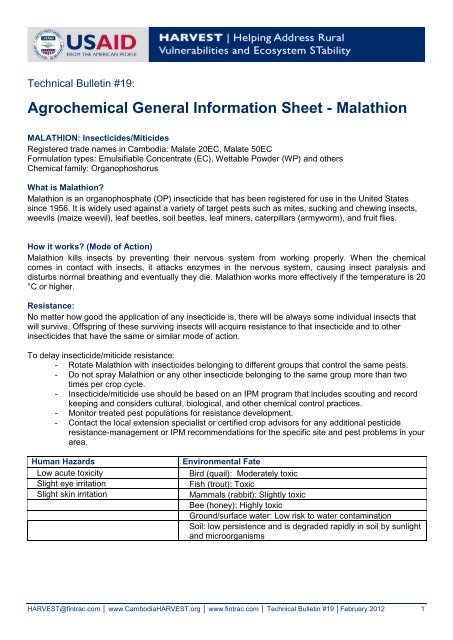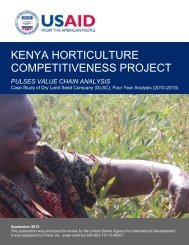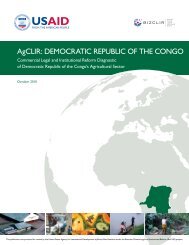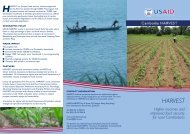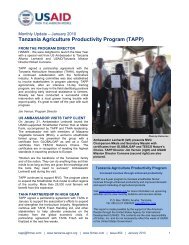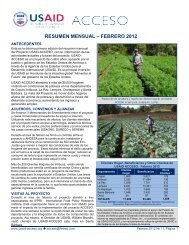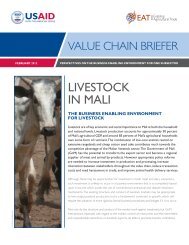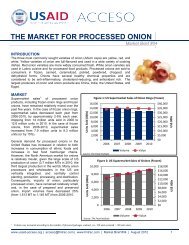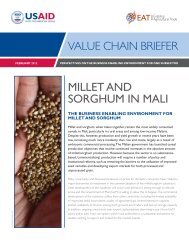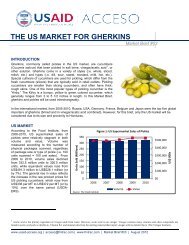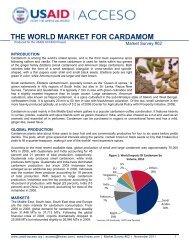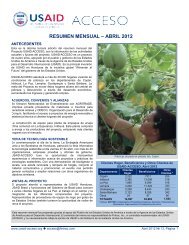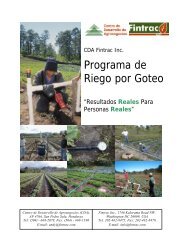Agrochemical General Information Sheet - Malathion - Fintrac Inc.
Agrochemical General Information Sheet - Malathion - Fintrac Inc.
Agrochemical General Information Sheet - Malathion - Fintrac Inc.
You also want an ePaper? Increase the reach of your titles
YUMPU automatically turns print PDFs into web optimized ePapers that Google loves.
Technical Bulletin #19:<br />
<strong>Agrochemical</strong> <strong>General</strong> <strong>Information</strong> <strong>Sheet</strong> - <strong>Malathion</strong><br />
MALATHION: Insecticides/Miticides<br />
Registered trade names in Cambodia: Malate 20EC, Malate 50EC<br />
Formulation types: Emulsifiable Concentrate (EC), Wettable Powder (WP) and others<br />
Chemical family: Organophoshorus<br />
What is <strong>Malathion</strong>?<br />
<strong>Malathion</strong> is an organophosphate (OP) insecticide that has been registered for use in the United States<br />
since 1956. It is widely used against a variety of target pests such as mites, sucking and chewing insects,<br />
weevils (maize weevil), leaf beetles, soil beetles, leaf miners, caterpillars (armyworm), and fruit flies.<br />
How it works? (Mode of Action)<br />
<strong>Malathion</strong> kills insects by preventing their nervous system from working properly. When the chemical<br />
comes in contact with insects, it attacks enzymes in the nervous system, causing insect paralysis and<br />
disturbs normal breathing and eventually they die. <strong>Malathion</strong> works more effectively if the temperature is 20<br />
°C or higher.<br />
Resistance:<br />
No matter how good the application of any insecticide is, there will be always some individual insects that<br />
will survive. Offspring of these surviving insects will acquire resistance to that insecticide and to other<br />
insecticides that have the same or similar mode of action.<br />
To delay insecticide/miticide resistance:<br />
- Rotate <strong>Malathion</strong> with insecticides belonging to different groups that control the same pests.<br />
- Do not spray <strong>Malathion</strong> or any other insecticide belonging to the same group more than two<br />
times per crop cycle.<br />
- Insecticide/miticide use should be based on an IPM program that includes scouting and record<br />
keeping and considers cultural, biological, and other chemical control practices.<br />
- Monitor treated pest populations for resistance development.<br />
- Contact the local extension specialist or certified crop advisors for any additional pesticide<br />
resistance-management or IPM recommendations for the specific site and pest problems in your<br />
area.<br />
Human Hazards Environmental Fate<br />
Low acute toxicity Bird (quail): Moderately toxic<br />
Slight eye irritation Fish (trout): Toxic<br />
Slight skin irritation Mammals (rabbit): Slightly toxic<br />
Bee (honey): Highly toxic<br />
Ground/surface water: Low risk to water contamination<br />
Soil: low persistence and is degraded rapidly in soil by sunlight<br />
and microorganisms<br />
HARVEST@fintrac.com │ www.CambodiaHARVEST.org │ www.fintrac.com │ Technical Bulletin #19 │February 2012 1
<strong>Agrochemical</strong> <strong>General</strong> <strong>Information</strong> <strong>Sheet</strong> - <strong>Malathion</strong><br />
Technical Bulletin #19<br />
February 2012<br />
First aid measures:<br />
Inhalation: Move person to fresh air. If person is not breathing, call a health center or doctor immediately<br />
for further treatment advice.<br />
Skin Contact: Take off contaminated clothing. Rinse skin with plenty of water for 15-20 minutes. Call a<br />
health center or doctor for treatment advice.<br />
Eye Contact: Hold eye open and rinse slowly and gently with water for 15-20 minutes. Remove contact<br />
lenses, if present, after the first 5 minutes, then continue rinsing eye. Call to health control center or doctor<br />
for treatment advice.<br />
Ingestion: Call a health center or doctor immediately for treatment advice. Do not induce vomiting unless<br />
told to do so by a poison control center or doctor. Do not give anything by mouth to an unconscious person.<br />
Mitigation Measures:<br />
- Applicator must wear protective clothing such as long sleeved shirt and long pants, rubber gloves,<br />
boots, goggles, etc.<br />
- Wash with soap and water after use.<br />
- Do not eat, drink, or smoke while preparing or applying pesticides.<br />
- Avoid allowing children, pets, or sensitive people in treatment areas to prevent accidental exposures<br />
during pesticide applications.<br />
- Chemical mix tanks have to be cleaned in designated areas.<br />
- Apply under favorable weather conditions (no wind or rain).<br />
- Do not contaminate water, food, or feed by improper storage or disposal.<br />
- Do not store and do not use in or around the home.<br />
- Do not reuse containers for any purpose.<br />
- Rotate use with other chemicals.<br />
- Correct implementation of IPM practices.<br />
- Do not use near open water sources.<br />
- Do not apply when bees are active.<br />
USAID-HARVEST<br />
No. 46 Street 310 │ Sangkat, Beong Keng Kang 1<br />
Khan Chamkamorn │ Phnom Penh, Cambodia<br />
Tel: 855 (0) 23 996419<br />
This bulletin is made possible by the support of the<br />
American People through the United States Agency for<br />
International Development (USAID). The content is the sole<br />
responsibility of <strong>Fintrac</strong> <strong>Inc</strong>. and does not necessarily reflect<br />
the views of USAID or the United States Government.<br />
HARVEST@fintrac.com │ www.CambodiaHARVEST.org │ www.fintrac.com │ Technical Bulletin #19 │February 2012 2


